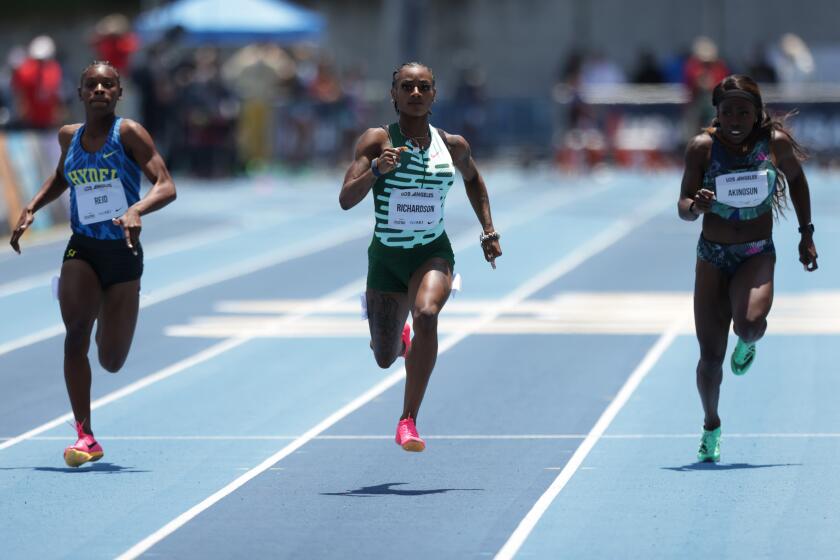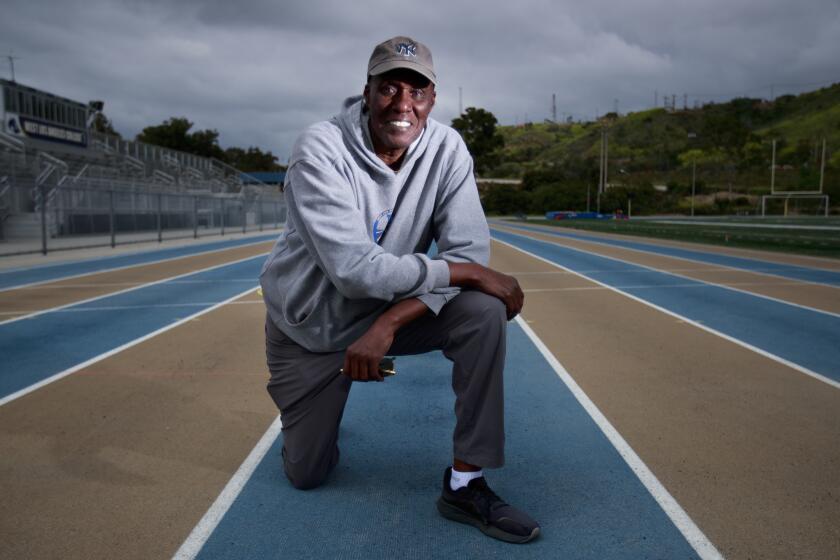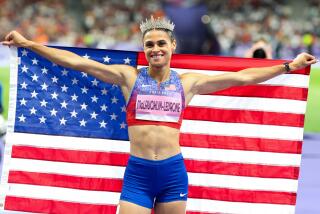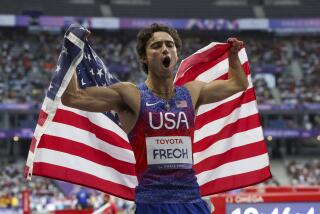History’s best shot putter smashes world record with new technique at L.A. Grand Prix
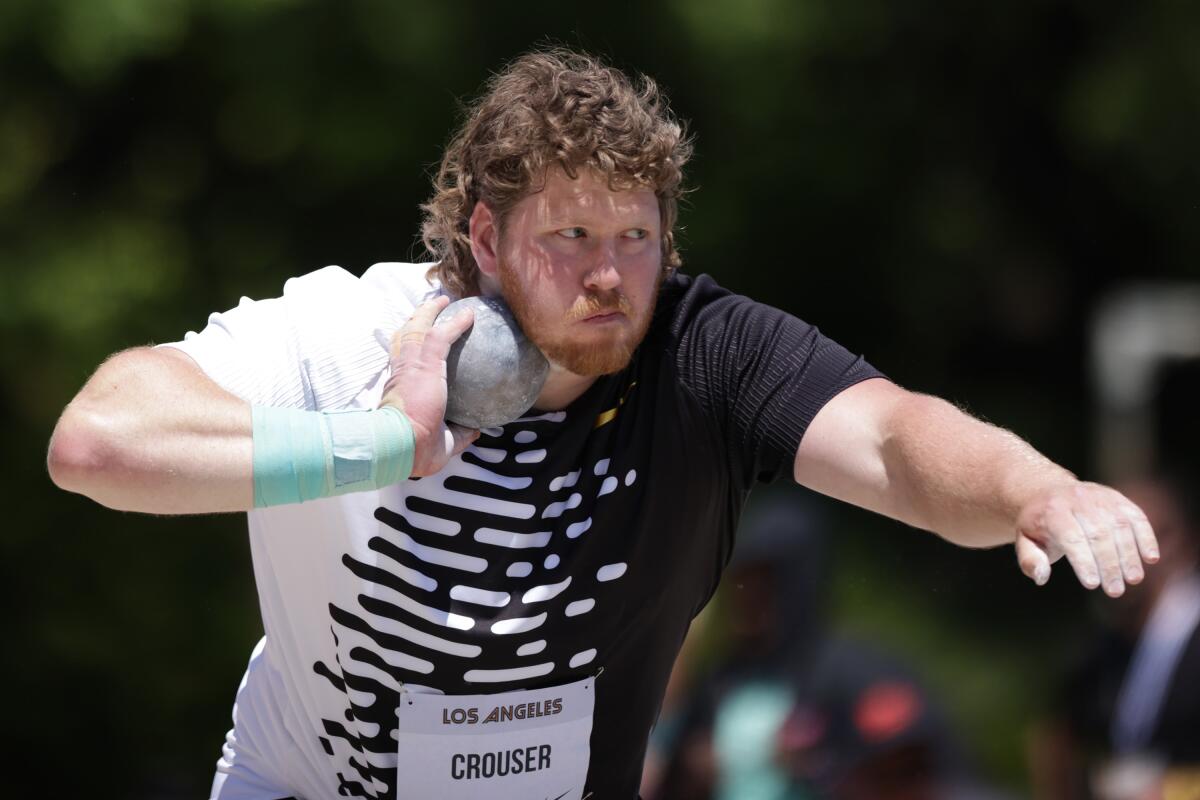
- Share via
Ryan Crouser has a background in engineering, a master’s degree in finance, a night-owl’s schedule and a curiosity to innovate that does not lead him to be idle for long. It is not unusual, he said, for his training partner to return for a new week of workouts, only for Crouser to giddily ask him to try a new exercise he has spent the weekend testing.
“Every time he’s like, ‘Not again,’” Crouser said.
Self-coached and with little historical precedent to draw upon for guidance as a dominant, tall — he is 6 foot 7— thrower using a rotational technique, he has been left to build his own throwing style. He had tried many before, with no luck. Then one night last December, around 10 p.m., his tinkering led him to what he called a “light-bulb moment.” Inside the barn’s 7-foot diameter shot-put ring, Crouser shifted where he started his spin a little farther to the right. It made his first step wider and added a new step into his approach.
“Longer step, longer radius, longer acceleration path on the ball,” Crouser said.
The L.A. Grand Prix was hoping to have more star power on display as it tries to help make track and field more popular ahead of the 2028 Olympics.
He calls it the “step-across.” Others have dubbed it the “Crouser slide.” Perhaps, based on his performance in front of 7,249 fans at UCLA’s Drake Stadium during Saturday’s Los Angeles Grand Prix, this is the best description: History’s best shot putter just found a way to get better.
Crouser’s new technique “clicked” for the first time in a meet, and it resulted in a hurl of 77 feet, 3¾ inches, about seven inches farther than Crouser’s previous world record set in 2021.
“I’m really excited because it didn’t feel polished,” Crouser said. “It felt like I had a ton of power and caught a big one but there’s still a lot more there.”
Of Crouser’s 10 longest throws before Saturday, only two had come in May or earlier. Crouser spends an entire year of training to peak for around 10 days, timed around major meets, so such a big throw, so early in the schedule, could bode well for big things leading into July’s U.S. championships, and August’s world championship, where Crouser will attempt to defend his title from last year.

A self-described math and physics guy, Crouser does not believe a limit exists on how far the 16-pound, metal ball can be thrown. But he knows these are the variables that will decide it: release point, velocity, training, technique and confidence.
“I think 23.70 [meters] is very possible and a conservative estimate,” said Crouser, whose record throw measured 23.56 meters. “I think 24 is humanly possible, it’s just at that point you’re kind of playing with magic and hoping to catch lightning in a bottle.”
USA Track & Field put a large budget into Saturday’s meet in its own hopes to capture its own breakthrough moment.
The sport is often beleaguered by concerns about its popularity, or lack thereof, and planting a meet with deep fields in Los Angeles has been a top priority for the governing body as it plotted a strategic plan to use the 2028 Olympics as a springboard for its relevance. The meet, which filled about three-quarters of the stands, was also followed by a concert.
Bobby Kersee has helped transform Sydney McLaughlin-Levrone, Athing Mu and many others into champion runners — and he shows no signs of slowing down.
For differing reasons, but largely because of health precautions, several high-profile athletes once billed to compete Saturday pulled out in the days and weeks beforehand, including Rai Benjamin, Michael Norman, Sydney McLaughlin-Levrone and Athing Mu, all of whom train in Los Angeles and would have been marquee draws. Those who did show up included Mondo Duplantis, the world-record pole vaulter who won at 19 feet, 4 ¾ inches.
Sha’Carri Richardson presented another highly anticipated reason to watch. The sprinter ran a heavily wind-aided 10.57 in the 100 meters in April and a legal, world-leading 10.76 on May 5. Only two-hundredths of a second behind Richardson on this year’s list of world-leading times was Marie-Josée Ta Lou. Both won their qualifying heats Saturday but did not run in the final, along with Aleia Hobbs, leaving a literal void with their lanes empty during a signature event at the climax of NBC’s national broadcast window.
A USATF spokesperson said cramping led Richardson to withdraw. Hobbs didn’t run as a precaution after feeling pain in her knee while warming up for the final, her agency said.

Richardson’s absence at a key U.S. meet with high exposure followed a tumultuous two years in which she became one of the few track and field athletes to make the cross-cultural leap into relevance in 2021 by first winning the U.S. Olympic trials with auburn-dyed hair, ornate nails and what-you-see-is-what-you-get personality, then being barred from competing in Tokyo after testing positive for marijuana. She vowed to win at the world championships the following summer, but didn’t even qualify for the meet.
“I keep saying this. I’m not back — I’m better,” Richardson said Friday. “Because these last three years I’ve shown y’all what I could do. It just was me that was standing in my way.”
The spotlight is back on Richardson, now for her fast times. She has said she has learned to avoid media coverage of her.
“Last year I was angry,” she told reporters Friday. “I saw red everywhere I went, and I was going to make sure everybody felt that as well. Now I’m to a point where I see me. And I want everybody everywhere I go to see me.”
They saw her comeback Saturday, for 10.90 seconds.

More to Read
Go beyond the scoreboard
Get the latest on L.A.'s teams in the daily Sports Report newsletter.
You may occasionally receive promotional content from the Los Angeles Times.

